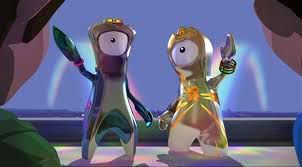
Like most people, I assume that you’ve always wondered what would happen if Kang, Kodos, and the T-2000 made babies together. Oh, you haven’t? Well, the question must have been plaguing the British collective conscious for some time, because it’s the only explanation for London’s 2012 Olympic mascots.
Wenlock and Mandeville are two liquid-metal, cyclopses – I believe this is the plural of cyclops; information on this subject is sparse since they are usually loners. The hermaphrodite monsters, each with his/her own mysterious markings, will adorn everything from baseball caps to QVC decorative plates, as the ring in the 2012 games.
According to the official Wenlock and Mandeville website, the three points on top of Mandeville’s head represent the winners’ podium. The lights above their (respective) eyes represent London taxis. Mandeville’s wristwatch embodies personal excellence. The list goes on, but I, along with most people, do not care. If you need to explain what should be a generic symbol, the creator has missed the point. While Wenlock and Mandeville are clearly the most horrifying mascots in Olympic history, we should have seen this coming.
The tradition of Olympic mascots dates back to the 1968 Grenoble games. (Yes, unfortunately there’s no cute cartoon to symbolize the 1936 Oympiad. However, I assume it would have been a sterner version of 1984’s eagle). France’s ‘Schuss,’ who was basically the red 7-UP ball on skis, was just the beginning of what would become a (sometimes) proud Olympic tradition.
For the 20 years that followed Schuss’ reign, Olympic mascots continued to be slightly altered versions of cereal spokesmen. Tony the Tiger became South Korea’s Hodori. Sugar Bear became the adorable symbol of Soviet rule in 1980. The characters’ designs neatly lent themselves to stuffed animals and commemorative cups. Olympic mascots were in a golden age, but it wouldn’t last.
From January until May, 1992 had all the markings of a banner year. Rick Moranis was blowing up children, to the delight of audiences across the country. Paul Heinreid had done us all a favor by finally dying. Life was good. Then came Spain. Until this point, nearly all Olympic mascots had been chosen through nationwide art contests, where young citizens competed to color within the lines. The youth vote was most apparent the year of Canada’s beaver mascot. But, despite these past successes with child labor, Spain bucked tradition and limited the competition to a handful of the country’s best known artists. Eventually, they settled on Javier Mariscal. Spanish authorities did have a point. Why rely on children’s drawings when you can turn to a cubist most known for crafting urinals that look like lips?
Mariscal gave the world CoBi the Catalan sheepdog. First of all, if you’ve ever seen The Shaggy Dog, Annie, or watched a mopey Sarah McLachlan commercial, you know that CoBi does not look like a sheepdog – if anything, he looks like a flattened Chihuahua drawn by Klasky Csupo. Half the time, CoBi was naked, leaving his Olympic chest tattoo for all the world to admire. The rest of the time, the one-dimensional quadruped wore a business suit with white sneakers. White sneakers. The fact that the ‘B’ in CoBi was capitalized for no other reason than to be quirky is more than enough reason to not only hate Spain’s Olympic committee, but to despise the entire country. While I’ll admit that my reaction to CoBi is a tad on the strong side, he and he alone paved the way for the Island of Misfit Mascots that would follow.
From 1992 onward, Olympic mascots were increasingly designed by ‘experts’ and grew increasingly bizarre. There was the Whatizit/Izzy/Sperm Wearing High Tops debacle of 1996, Owls drawn by mental patients in 1998, and the Greek monsters of 2004. Although Sydney’s kookaburra, platypus, and echidna were a brief return to sanity, it didn’t last. Which brings us to today. Which brings us to Wenlock and Mandeville. Given the elaborate backstories that were given to these amorphous metal alloys, it’s clear that these hideously deformed monsters took far longer to design than any cute, likeable mascot would have. All we wanted was a fox in a riding jacket. Was that too much to ask for, London?
You're actually kinda funny, for a girl.
ReplyDeleteAw, shucks! Well bless your cotton socks, Mike Gammariello!
ReplyDeleteAhem. Excuse me. Misha Bear is his own thing. He's not Sugar Bear. He's . . . NOT! *sobs* *slams door to bedroom*
ReplyDelete(That was funny. Thanks!)
Firstly, the plural of cyclops is cyclopes.
ReplyDeleteSecondively, what's your beef with Paul Henreid?
This was, easily, my favorite piece of all the sports ones. Hilarious and brilliant! Not to mention EXTREMELY educational. Good job, Sabrina!
ReplyDelete